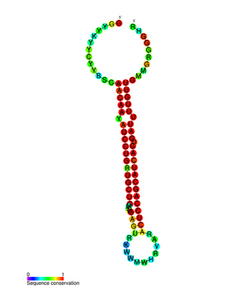Biology:miR-338
| miR-338 | |
|---|---|
 Conserved secondary structure of miR-338 microRNA precursor | |
| Identifiers | |
| Symbol | miR-338 |
| Alt. Symbols | MIR338 |
| Rfam | RF00686 |
| miRBase | MI0000814 |
| miRBase family | MIPF0000097 |
| NCBI Gene | 442906 |
| HGNC | 31775 |
| OMIM | 614059 |
| RefSeq | NR_029897 |
| Other data | |
| RNA type | miRNA |
| Domain(s) | Mammalia |
| GO | 0035195 |
| SO | 0001244 |
| Locus | Chr. 17 q25.3 |
| PDB structures | PDBe |
miR-338 is a family of brain-specific microRNA precursors found in mammals, including humans.[1] The ~22 nucleotide mature miRNA sequence is excised from the precursor hairpin by the enzyme Dicer.[2] This sequence then associates with RISC which effects RNA interference.[3]
miR-338 is located in an intronic region within the gene for apoptosis-associated tyrosine kinase (AATK). It has been predicted that it may downregulate genes which have a downstream negative effect on AATK expression.[4]
Function
miR-338 is a brain-specific miRNA which regulates the expression of cytochrome c oxidase IV (COX4).[1][5] The mature miR-338 miRNA sequence is complementary to a short section of the 3' untranslated region of COX4 mRNA. This mRNA sequence is presented atop a stem-loop structure, indicating it is accessible to miRNA processing.[5]
Applications
miR-338 is dysregulated in neuroblastoma, and could potentially be implemented as a biomarker or future therapeutic agent.[6] miR-338 has also been linked with hepatocellular carcinoma, and a large-scale diagnostic test has been suggested involving measurement of miR-338 expression in tissue samples.[7] Furthermore, miR-338 is one of seven microRNAs whose expression profiles can be combined to give a prediction of the probability of survival of a patient with gastric cancer.[8]
References
- ↑ 1.0 1.1 "MicroRNA-338 regulates local cytochrome c oxidase IV mRNA levels and oxidative phosphorylation in the axons of sympathetic neurons". The Journal of Neuroscience 28 (47): 12581–90. Nov 2008. doi:10.1523/JNEUROSCI.3338-08.2008. PMID 19020050.
- ↑ "microRNAs: tiny regulators with great potential". Cell 107 (7): 823–6. Dec 2001. doi:10.1016/S0092-8674(01)00616-X. PMID 11779458.
- ↑ "Human RISC couples microRNA biogenesis and posttranscriptional gene silencing". Cell 123 (4): 631–40. Nov 2005. doi:10.1016/j.cell.2005.10.022. PMID 16271387.
- ↑ "An intronic microRNA silences genes that are functionally antagonistic to its host gene". Nucleic Acids Research 36 (16): 5232–41. Sep 2008. doi:10.1093/nar/gkn513. PMID 18684991.
- ↑ 5.0 5.1 "Axonal protein synthesis and the regulation of local mitochondrial function". Cell Biology of the Axon. Results and Problems in Cell Differentiation. 48. 2009. pp. 225–42. doi:10.1007/400_2009_1. ISBN 978-3-642-03018-5.
- ↑ "MIR152, MIR200B, and MIR338, human positional and functional neuroblastoma candidates, are involved in neuroblast differentiation and apoptosis". Journal of Molecular Medicine 88 (10): 1041–53. Oct 2010. doi:10.1007/s00109-010-0643-0. PMID 20574809.
- ↑ "Bead-based microarray analysis of microRNA expression in hepatocellular carcinoma: miR-338 is downregulated". Hepatology Research 39 (8): 786–94. Aug 2009. doi:10.1111/j.1872-034X.2009.00502.x. PMID 19473441.
- ↑ "Survival prediction of gastric cancer by a seven-microRNA signature". Gut 59 (5): 579–85. May 2010. doi:10.1136/gut.2008.175497. PMID 19951901.
Further reading
- "[Interaction of microRNA-338 and its potential targeting protein eiF4E3]". Zhejiang da Xue Xue Bao. Yi Xue Ban = Journal of Zhejiang University. Medical Sciences 39 (6): 583–8. Nov 2010. doi:10.3785/j.issn.1008-9292.2010.06.006. PMID 21166051. (Chinese)
- Akbarian, Schahram, ed (2008). "A miRNA signature of prion induced neurodegeneration". PLOS ONE 3 (11): e3652. doi:10.1371/journal.pone.0003652. PMID 18987751. Bibcode: 2008PLoSO...3.3652S.
External links
 |

